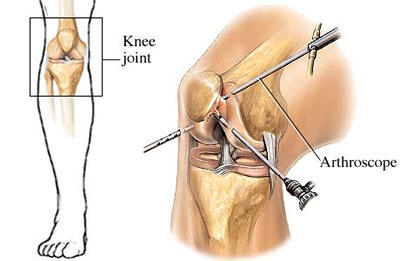What's New
What is Arthroscopy
Arthroscopic surgery, often misspelled and mispronounced as orthoscopic surgery, consists of viewing a joint with a small camera inserted through an incision in the skin. Arthroscopy is most commonly performed on the knee joint, but it can also be used on the wrist, ankle, shoulder, or hip.
The term arthroscopic is derived from the Greek roots arthro, meaning 'joint', and scopein, meaning 'to see'. In arthroscopic surgery, small incisions are made around the joint to admit a camera called an arthroscope and any other required surgical instruments. The incisions are only a centimeter or two long and leave minimal scarring. Recovery time is also significantly shorter than with open joint surgery.
Arthroscopic surgery can be used to diagnose and to repair joint problems. The arthroscope can be used to take pictures of the inside of the joint that can be evaluated by a doctor, and it also provides a video image on a television screen during surgery, so that the surgeon can see what he or she is doing without opening up the joint. The arthroscope is about the size of a pencil and features both a magnifying lens and a fiber optic light to make the photographed areas clearly visible.
Arthroscopic surgery can be used to treat a wide range of conditions, including synovitis, or inflammation of the joint lining; tears in the rotator cuff tendons or in the cartilage or ligaments of the knee; arthritis related problems; and carpal tunnel syndrome. Some conditions still require open joint surgery, but arthroscopic surgery has become increasingly sophisticated and versatile since the procedure became widely used in the 1980s.
Arthroscopy has revolutionized the treatment of joint injuries and ligament injuries. It is a minimally invasive procedure that is most commonly performed in the knee joint. It provides the surgeon with an accurate diagnosis and adds to or modifies the diagnosis made after clinical examination and investigations. While arthroscopic surgery is considered a minimally invasive procedure, it does require anaesthesia, either local or general. It is usually an outpatient procedure, and few patients require much medication for pain. Recovery is fairly quick, with the incision wounds healing in a few days and maximal recovery of the joint occurring over several weeks. Rehabilitation or physical therapy may be required during the recovery period.As the morbidity of the procedure is low, the time to recovery is minimal and the patient can be discharged the same day.
Ligament injuries inside joints are most common in the knee joint and less so in the shoulder and ankle joints. These include meniscus tears, cruciate ligament ruptures etc. Treatment involves meniscus repairs, excision of torn bits of menisci, augmentation or reconstruction of cruciate ligaments etc.
Arthroscopy is performed for removal of loose bodies, repair of peripheral tears of menisci, excision of torn bits of menisci, reconstruction of anterior cruciate ligament, synovectomy, abrasion chondroplasty, debridement of the knee joint in degenerative arthritis etc.
Like all surgery, arthroscopic surgery has a few associated risks. These include infection, excessive bleeding or swelling, blood clots, nerve or blood vessel damage, and instrument breakage. However, less than one percent of all arthroscopic surgery procedures have any of these complications.
